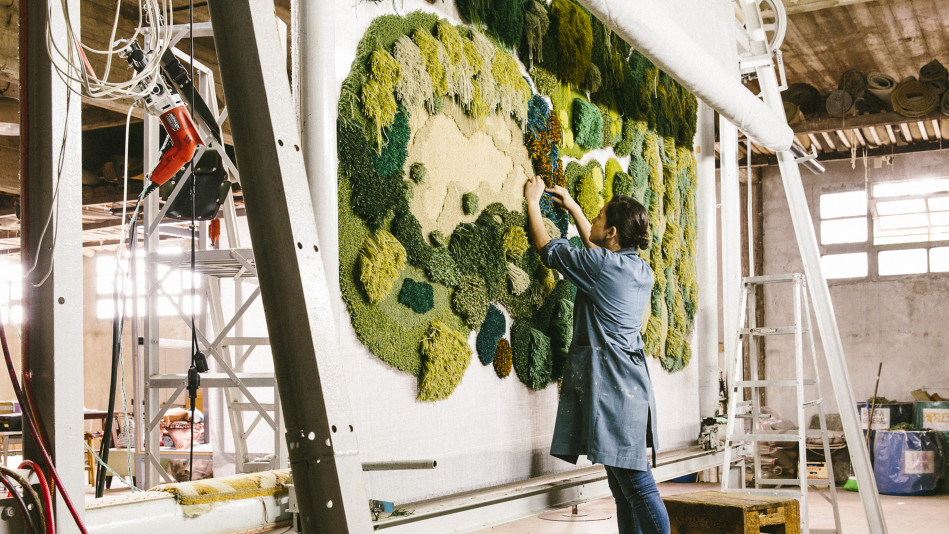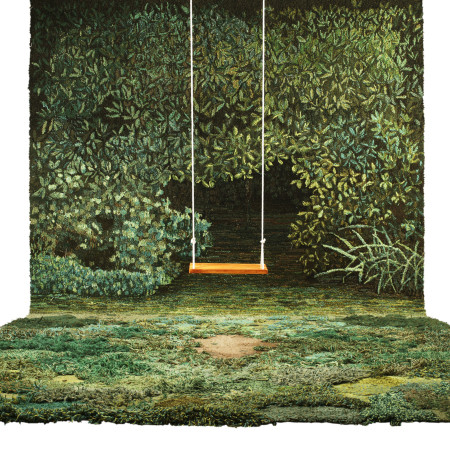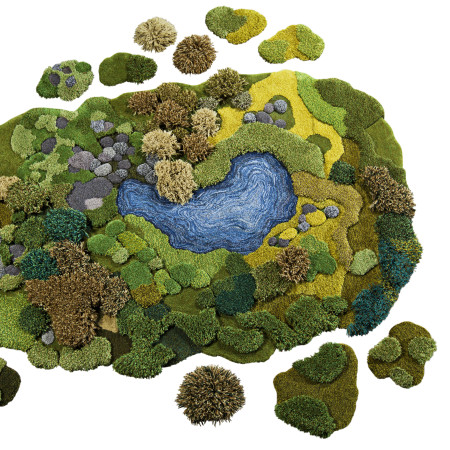These Carpets Will Turn Your Home Into a Lush Woodland
Alexandra Kehayoglou can really cut a rug.

Photo: Emiliano Granado
For most of us, a carpet is a way to keep our feet warm in winter. For Alexandra Kehayoglou, it's an entire world: The textile artist uses scraps of yarn to create intricate, occasionally trippy topographies that evoke the natural beauty of her native Argentina, with its swirling blue lakes, rippling verdant grasslands, and craggy white glaciers.
Dyed-in-the-Wool
"My entire life has revolved around carpeting," says Kehayoglou, 34, whose Greek grandmother began making handwoven mats in the 1940s. "My grandparents opened a carpet company, El Espartano (which translates to The Spartan), in 1956, and my family still runs it." But Kehayoglou, who studied painting in art school, didn't immediately embrace her fuzzy fate. It wasn't until she began designing commercial carpets for El Espartano in 2007 that she discovered she could make tactile canvases, and she started squirreling away scraps to experiment with. One year later, she held her first textile-art exhibition in Buenos Aires. "I realized I could use material from my family's business," she says, "to create my own vision."

A moment of stillness in the meandering textile Shelter for a Memory (2012)
Spinning a Yarn

A three-by-two-meter piece titled Human Nature Pastizal (2015)
Kehayoglou's work philosophy echoes her environmental interests: She uses discarded or surplus wool for her pieces, which have caught the attention of homeowners, museum curators, and high-end designers alike. Kehayoglou handcrafts each rug with an electric tufting gun and then meticulously sculpts and trims strands with carpet scissors. Handling all that fiber means she often brings her work home—literally. "My black coats are always covered in bits of colored wool," she says. "I'm okay with it. I don't even own a lint roller."
Open Floor Plan
Kehayoglou hopes her fluffy worlds imbue ordinary materials with enchantment. "My carpets are environments you can physically and mentally enter," she says. "For kids, it's natural to get down on the floor, but that doesn't happen so often with adults." Kehayoglou wants to change that. "Seeing people interact with my pieces is a whole new source of inspiration," she says, "and I think my work can make you see something you might otherwise miss."
By the Numbers
164 Approximate length, in feet, of the one-of-a-kind woodland-inspired runway Kehayoglou tufted for fashion designer Dries Van Noten in 2014.
Photos: Francisco Nocito/Courtesy of Alexandra Kehayoglou Studio
Dyed-in-the-Wool
"My entire life has revolved around carpeting," says Kehayoglou, 34, whose Greek grandmother began making handwoven mats in the 1940s. "My grandparents opened a carpet company, El Espartano (which translates to The Spartan), in 1956, and my family still runs it." But Kehayoglou, who studied painting in art school, didn't immediately embrace her fuzzy fate. It wasn't until she began designing commercial carpets for El Espartano in 2007 that she discovered she could make tactile canvases, and she started squirreling away scraps to experiment with. One year later, she held her first textile-art exhibition in Buenos Aires. "I realized I could use material from my family's business," she says, "to create my own vision."

A moment of stillness in the meandering textile Shelter for a Memory (2012)
Spinning a Yarn

A three-by-two-meter piece titled Human Nature Pastizal (2015)
Kehayoglou's work philosophy echoes her environmental interests: She uses discarded or surplus wool for her pieces, which have caught the attention of homeowners, museum curators, and high-end designers alike. Kehayoglou handcrafts each rug with an electric tufting gun and then meticulously sculpts and trims strands with carpet scissors. Handling all that fiber means she often brings her work home—literally. "My black coats are always covered in bits of colored wool," she says. "I'm okay with it. I don't even own a lint roller."
Open Floor Plan
Kehayoglou hopes her fluffy worlds imbue ordinary materials with enchantment. "My carpets are environments you can physically and mentally enter," she says. "For kids, it's natural to get down on the floor, but that doesn't happen so often with adults." Kehayoglou wants to change that. "Seeing people interact with my pieces is a whole new source of inspiration," she says, "and I think my work can make you see something you might otherwise miss."
By the Numbers
164 Approximate length, in feet, of the one-of-a-kind woodland-inspired runway Kehayoglou tufted for fashion designer Dries Van Noten in 2014.
Photos: Francisco Nocito/Courtesy of Alexandra Kehayoglou Studio



